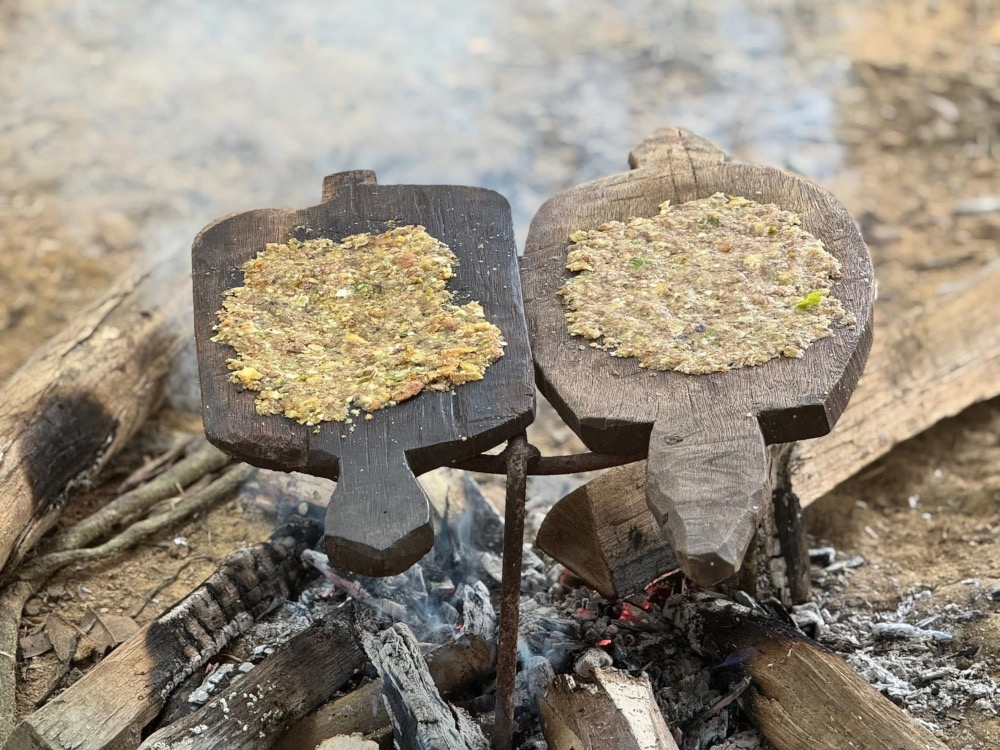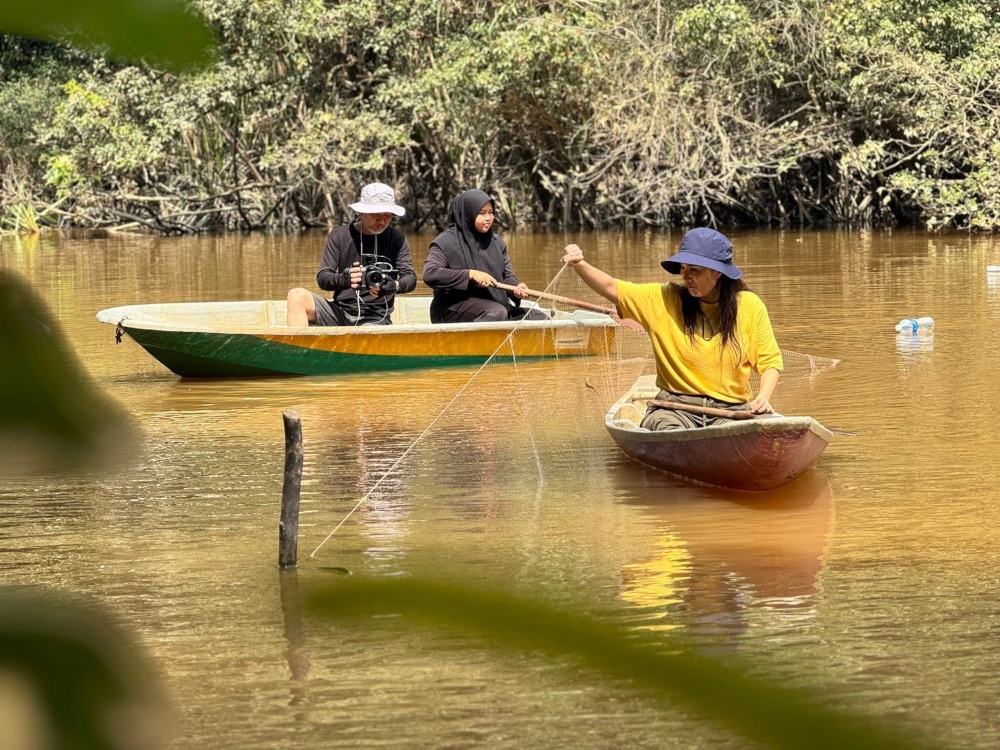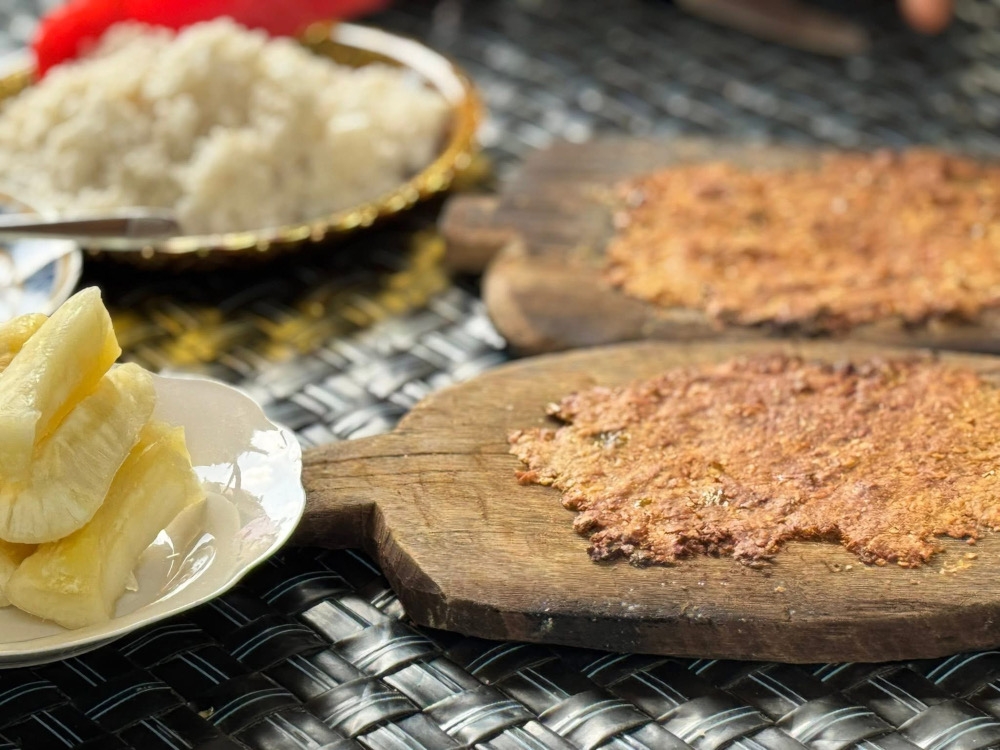KUALA LUMPUR, Nov 11 — Actress, filmmaker, producer and director Iman Corinne Adrienne thought she knew what it meant to “rough it out” until she found herself hiking for hours through the jungles of Pahang with Orang Asli guides, chasing fish with bare hands and learning to make meals from rubber sap and wild bamboo shoots.
Recalling how gruelling the filming of her documentary titled Tribal Kitchen Asia turned out to be, she said: “I felt like I went on a survival trip. There were moments where I thought I was going to break because it was so hot and we were hiking for hours. It really tests your endurance and challenges me. I don’t think I’ve ever encountered anything like that,” she told Malay Mail.
A kitchen in the wild
In Tribal Kitchen Asia, Iman visits and participates in several Orang Asli tribes’ daily rituals and habits in order to learn and see what they are eating and how they sourced and cooked their meals.
She said she wanted to show a part of Malaysia that was rarely spoken or known much about. Or as she puts it: “things we didn’t even know about Malaysia” and how bringing these real stories to life could change perspectives.
So when Tribal Kitchen Asia came along, it felt to her like a long-delayed calling finally fulfilled.
“It was something I had manifested years ago,” she said.
Iman and the crew try hand-catching fish with the Batek Nong tribe, digging among slippery river rocks in the rushing current — a method she called the most challenging of all. — Picture courtesy of Happy Campers Productions
“If I were to host again, I wanted it to be meaningful — something in-depth, where people don’t just learn facts about the Orang Asli, but really understand how they live and what their daily life feels like.”
Over nearly three weeks, she journeyed deep into Pahang’s forests to live among six tribes each with their own rhythms, languages and ways of surviving off the land.
The six tribes featured in the six-part series are the Jah Hut, (Kampung Paya Pelong, Kerdau, Temerloh), Bateq Nong (Kampung Sungai Berjuang, Jerantut), Semelai (Kampung Jelawat, Pos Iskandar, Bera), Temiar (Kampung Terakit, Pos Telanok, Cameron Highlands), Semai (Cameron Highlands), and the Che Wong (Kampung Baek, Kuala Gandah, Lanchang).
“Each village was different. Some were shy and private, others were open and friendly. But all of them share this instinctive connection with nature,” she said.
Each community welcomed Iman and her small film crew of about a dozen people for a few intense days of shooting that pushed everyone to their limits.
The team filmed back-to-back for 18 to 20 days, often hiking several hours to reach villages where no car could go.
Sedated fish, rubber seed ‘sambal’ and wild potatoes
Unlike most food shows, Tribal Kitchen Asia begins where ingredients live — in the forest. Every meal starts with a hunt or a harvest.
“If we wanted to cook two dishes we had to find everything ourselves. Chop bamboo, dig for yams, catch fish, pluck herbs. Nothing came from a supermarket, it was all blood and sweat,” said Iman.

The never-before-seen ‘sambal tepek’ or ‘sambal biji getah’ made from the sap of the rubber tree. — Picture courtesy of Happy Campers Productions
One of her toughest experiences came in Jerantut with the Bateq Nong tribe, while filming a traditional fishing ritual for a dish called Ikan Badong Chiak.
“We had to find a special tree called Chiak. You chop its fruit, carry it to the river, and pound it until the sap runs into the water. The juice sedates the fish, then you chase them downstream and catch them by hand. It was exhausting. We were climbing over rocks, sliding in the current.
“Meanwhile, the Orang Asli kids were sprinting barefoot like Olympic athletes. Their fitness level was incredible. I could barely keep up.”
It was a moment that stayed with her: watching the kids move through the jungle knowing every step and sound.
“It made me realise how far we’ve drifted from nature. For them the forest is not a challenge, its home.”
Among the dishes featured in the series, one stood out for its unexpected ingredient: rubber trees.
The Jah Hut tribe in Temerloh transforms the sap and seeds into sambal tepek, or sambal biji getah, a unique and flavourful sambal.

The Jakun tribe catch fish using the ‘jaring’ method. — Picture courtesy of Happy Campers Productions
“I’ve driven past rubber estates all my life but never imagined the sap or seeds could become food,” she said.
“The extract the getah (rubber), dry it and roast it before pounding it with fresh ingredients to make a sambal. It looks like tempeh but it’s not. It’s chewy, smoky and surprisingly high in protein.”
Other traditional recipes she learned included empeng (a Jah Hut roasted snack), ubi celek (boiled wild yam from the Temiar tribe) and lemang ubi, a Che Wong dish cooked in bamboo over an open fire.
She said cooking was as demanding as trekking.
“Every step from finding ingredients to pounding spices was physical. The women use long bamboo pestles moving in rhythm like their dancing. The sound of the water and herbs mixing — it’s hypnotic. It wasn’t just cooking, it was art,” she said.
The shy villagers and their supreme fitness

After catching fish in the rushing river with the Batek Nong tribe (Negrito), they cooked their catch over a barbecue and enjoyed a riverside picnic together. — Picture courtesy of Happy Campers Productions
One of Iman’s hardest journeys was to Kampung Baek, home of the Che Wong (Senoi) tribe. Accessible only by a two-hour jungle hike, it’s a small, reclusive community where only a few families live.
“The Che Wong people are shy,” she said.
“We had to hike in with all our gear. Meanwhile one elderly man, probably in his sixties, hiked with us, chopped two huge bamboo poles, and carried them all the way back himself. You just have to take your hat off. His strength and calmness were unbelievable.”
The contrast between this tiny settlement and the large Semelai community of Pos Iskandar, where more than a thousand Orang Asli live, gave her a sense of the diversity within Pahang’s indigenous world.
“You can’t generalise them,” she said.
“Each tribe has its own rhythm, its own story.”
Struggle to keep traditions alive

The ‘bubu’ trap for catching fish with the Semelai tribe at Kampung Jelawat, Pos Iskandar. The ‘bubu’ is put in the river overnight and is picked up by boat the next day. — Picture courtesy of Happy Campers Productions
Iman said the series also documents a quiet struggle, that of preserving heritage in the face of modern life.
“You see young people leaving for cities, working for delivery apps or in shops and slowly losing touch with what their parents and grandparents taught them,” she said.
“However there are also those who are trying to hold on planting herbs, cooking traditional food, living simply but meaningfully. They’re already practising what we call sustainability, they just call it living.”
Reflecting on the experience afterwards, Iman said it gave her a deeper appreciation for the art of survival and the strength that comes with it.
“I think I have a newfound respect for primitive survival skills,” she said.
“Going through it gave me a deeper connection to nature. It’s instilled this quiet sense of confidence in me. It wasn’t a walk in the park, there were days I thought I wouldn’t make it, especially when the heat got overwhelming, but I did it.
“And now it makes me want to challenge myself even more in life.”

Pounded with spices and cooked over heat, the ‘sambal tepek’ or ‘sambal biji getah’ was one of the most unique dishes featured in the show. — Picture courtesy of Happy Campers Productions
Though best known for her acting career, Iman has also spent years working behind the camera producing, hosting and learning the craft of documentary storytelling. She said making Tribal Kitchen Asia allowed her to blend both worlds.
“I went into documentaries without wishing for it, you know, and that was in 2016.
“I did that for an international show for Discovery. I took eight years off from acting, and I went behind the scenes to learn. I worked with a British producer, all that.
“So I realised that documentaries actually bring different perspectives to me and let me learn a lot, especially about Malaysia, the things that I really didn’t know about my own country.”
* The six-part Tribal Kitchen Asia documentary series, hosted by Iman Corinne Adrienne and produced/directed by Nurashikin Zaharuddin and Raja Badri of Happy Campers Productions, is slated to air locally on Bernama TV in January 2026, with streaming available on Walk About Asia OTT. International audiences will be able to catch the series on RT Documentary, though exact dates have yet to be confirmed.








